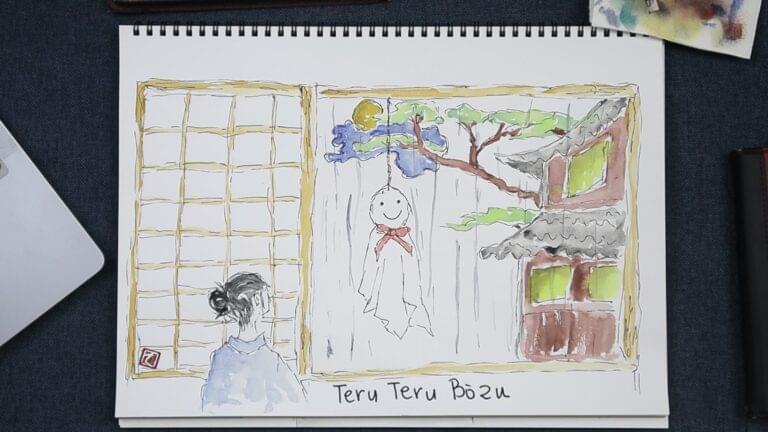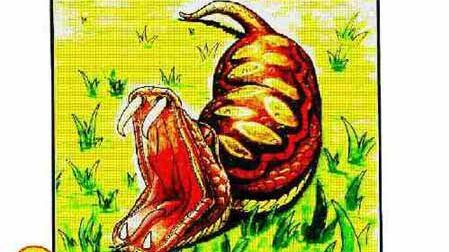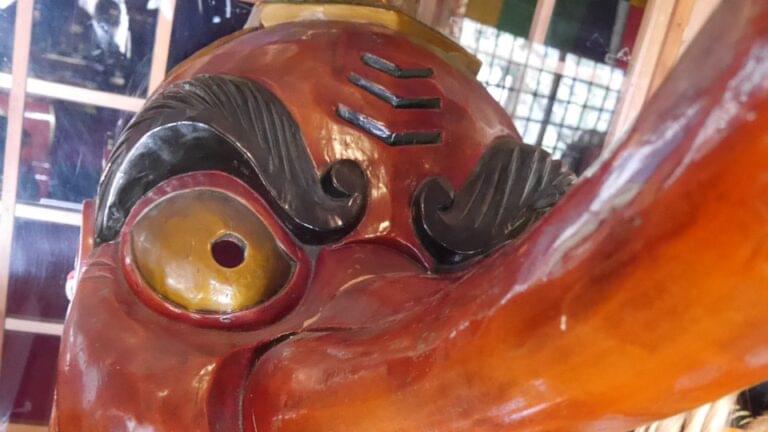An enormous red octopus creature that can stretch ten thousand square meters, little people who live under butterbur leaves, a ghost that holds up a torch at night and more.
I’m Thersa Matsuura and you’re listening to Uncanny Japan, a podcast about all the delightful and weird and lesser known nooks and crannies of Japanese culture.
What do You Think About When I Say Hokkaido?
I just got back from a short trip up north, so I have Hokkaido on the brain. Now, when you think about this northernmost island of Japan, what comes to mind? Sapporo ramen? Spicy soup curry with flash fried vegetables? Sweet corn on the cob or fluffy buttered potatoes? Maybe heaping rice bowls topped high with fresh seafood like crab, uni, ikura and shrimp? Or rolling hills of fragrant lavender. All those incredible sculptures at the Snow Festival? What about bears? Or how about the Ainu?
The Ainu
The Ainu are the indigenous people who live there; although there aren’t very many anymore.The official estimate is there are only around somewhere between 10,000 to 25,000 people left. As for speakers of the language it’s as few as 15, but maybe a hundred? It’s a sad terrible story with a lot of forced assimilation and colonization and making people move off their land. All that might sound familiar. It wasn’t until May 8th, 1997 – that the Japanese government enacted the Ainu Culture Promotion Law, officially acknowledging the existence of the Ainu as an ethnic minority. Just wow.
Anyway, we’re not getting into that today, instead we’ll be talking about a part of the Ainu culture that you don’t hear about very often and I’m just not getting into myself. Let’s delve into a handful of their very own yōkai or as the case may be, mythical creatures. I’ll cover six today.
The Korpokkur or Korbukkur
For the first yōkai from Hokkaido, we need to go back to ancient times, before the Ainu even got there and named it Yezo.
Imagine a race of little people who are speedy and agile, good at fishing and we’re going to learn in a second, kind. They lived in peace in holes in the ground that had giant butterbur leaves covering their roofs. I’m sure allowing them to blend into nature wonderfully.
Then out of nowhere, one day the Ainu showed up. But don’t worry, things don’t go bad right away. The Ainu discover these tiny people and name them the korpokkur or korbokkur (the p and be sounds aren’t distinguished in their language).
Korpokkur is a combination of “kor” which means the butterbur plant; “pok”, meaning under or below, and “kur”, person. The people below the leaves of the butterbur. Butterburs are called fuki in Japanese and have great big round leaves.
Another couple words for them was toichi-seunkuru or tonchi.
Toichi-seunkuru or tonchi seems to mean “the ones who live in a pit”. Which sounds kind of rough and wild, but might have been a brilliant idea considering the climate of Hokkaido. It seems digging about a meter down then placing pillars with a large sloping roof on top with plenty of ventilation and some butterbur leaves to make the ouse fancy would have kept the families cool in the summer and warm in the winter.
So these little people and the Ainu lived in harmony. The korpokkur, though, were shy and didn’t like to show their faces. Despite that, they did exchange goods and help each other. The Korpokkur gave these new people fish and deer to eat. They did this at night where they’d visit an Ainu home and pass the food through windows.
Well, one day a young Ainu man wanted to see what these little people looked like so he grabbed one and pulled them inside. This particular korpokkur was a woman who was dressed beautifully and had a tattoo on the back of her hand. She and her family and the entire race of people were appalled at this lack of respect from the people they had only tried to help. So after that day, they disappeared and were never seen again.
That tattoo on the back of the korpokkur’s hand is said to be the model for the ones that Ainu wives later would put on their own hands.
Maybe a Real Race of People
An interesting side note: some anthropologists think they were a real race of people and the Ainu came in from the north and displaced, possibly eradicated them. Why do they think this? Because archeologists found some old pottery, tools, and arrowheads that aren’t consistent with what the Ainu used. Maybe real. Maybe little yōkai.
The Akkoro Kamuy
For number two we have the Akkoro-kamuy. Just a heads up, you might hear the word kamuy a lot in Ainu mythology. A kamui is a spiritual being, supernatural entity, or deity. It’s similar to the Japanese kami, but I read that it’s not exactly the same. But I personally haven’t figured out the difference yet.
This beast called akkoro-kamuy is a giant red octopus that lives in Uchiura Bay. So big in fact that when it emerges from the water, even the sky is dyed red. For this reason, if there is ever a red sky people would stay away from the water knowing what was no doubt there.
If you were in a boat, though, and already on the water when the Akkoro-kamui showed up you might very well be doomed without so much as a chance. The creature was so big it could swallow ships and whales whole. Still fishermen were positive thinkers and had some grit, so they carried weapons like scythes with them just in case.
The Azui Kakura
Now if you think it’s only the akkoro-kamuy lurking in the Uchiura Bay, you’d be wrong. Coming in at number 3, there’s the azui-kakura or monster sea cucumber. Mostly this fellow hangs out at the bottom of the bay, occasionally latching on to a piece of driftwood with its mouth and floating somewhere else for a while.
The problem arises when it gets surprised and starts thrashing around. Then boats can be sunk. Or more adorable, at times it confuses the bottom of a wooden boat of a chunk of driftwood and grabs on. More boats are sunk.
The best part of the azui-kakura though is its origin story. It’s believed an ainu woman’s undergarment washed down a river and into the bay and magically transformed into the giant sea cucumber. Which is funny. But I did google the word mouru for the item of clothing and it seems to be like a big undershirt. Not underpants. Which would have been hilarious.
The Pentachi Koro Oyashi
Number 4 is the pentachi-koro-oyashi, meaning a “ghost that holds up a torch”. It’s said to wander around at night carrying this torch and doing all kinds of strange things to people who are out at night.
One story goes that a chief of a certain village was visiting another village called Kotankeshi. While there he saw a Pentachi-koro-oyashi. The area around it was as bright as daylight because of the powerful torch. Just then the chief of the Kotankeshi snuck up behind it and stabbed it in the back. The pentachi-koro-oyashi collapsed, but he also passed out. The next day he woke up, and ran back home. After the incident was relayed, some villagers went back to locate the pentachi koro oyashi’s body. What did they find? A dead raven. An evil raven evidently.
The Apeyaki or Abeyaki
Number 5 – since summer is here – let’s not forget the ape yaki or abe yaki. These little buddies came from the Horoizumi district and were basically cicada that were bright red because they were covered in flames. Fire cicada! If one or more landed in a tree it would immediately burn it to a black smoking crisp. They were, as you can guess, feared.
The Iwaetunnay
Sliding in at number 6 is the イワエトゥンナイ(iwaetunnay) or follow me here モシレチクチクイワエチクチク(mosirecikcik iwaecikcik).
These are fun too. They’re one-eyed flying monsters that live in the mountains. When they’re strolling or flying along, if they come across something in their way they can just zip right through it. Some versions or the story say they leave big holes in the obstacle.
The Hoyau Kamuy
Okay, let’s end today with number 7, the hoyau kamuy. While it’s a snake or dragon god, my favorite description of this one calls it a giant winged goblin shark. Another name for them is “sak-somo-ayep” which roughly translates to “the one who must not be mentioned during summer”.
What a strange name you may ask. Well, the reason is, the hoyau kamuy grow weak in the winter and strong in the summer. So when they’re at their strongest, you don’t want to go blathering on about them, lest they hear you.
These winged goblin dragon snakes live in lakes and they reek terribly. How terribly? Well, let me tell you. If a hoyau kamuy comes near plants, they wither and die. If you are standing downwind from one, your hair will fall out, and your skin will swell up, and if you get too close your skin will start to burn and you just might die.
There’s a story of a swamp in Hokkaido where one of these dragon gods lived or still lives. It’s considered a divine swamp. However, when people pass through the area they have to climb a hill to avoid accidentally being harmed by the beast.
But it’s stronger than that, because in those instances, it’s not even trying. The hoyau kamuy is also purported to have a powerful venom.
This snake dragon deity isn’t all bad though. There is a myth about one that lived in Lake Toya that when the god of smallpox called Payoka kamuy in Ainu came and started killing people left and right, everyone fled to the banks of the river. The hoyau kamuy bravely saved them by driving off the god of pox with its disgusting stench.
This particular hoyau kamuy wasn’t a winged goblin shark though, it looked like a big turtle with wings. Which is a nice image, too.
Okay, I’ll stop here. Like I said, I’m just myself starting to learn about the Ainu mythology and folktales. But I’ll keep studying and revisit when I find more interesting goodies.
Thank you for listening. Thank you patrons for supporting the show. I’ll talk to you all in two weeks. Oh, patrons, I’m working on some Hokkaido footage I’ll be put up for you soon.
Bye bye!






